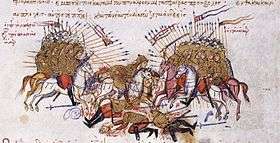Hikanatoi
| Hikanatoi | |
|---|---|
| Active | ca. 809 – latter 11th century |
| Country | Byzantine Empire |
| Type | Guards (cavalry unit) |
| Garrison/HQ | Constantinople, Bithynia, Thrace |
The Hikanatoi (Greek: Ἱκανάτοι, "the Able Ones"), sometimes Latinized as Hicanati, were one of the Byzantine tagmata, the elite guard units based near the imperial capital of Constantinople. Founded in the early 9th century, it survived until the late 11th century.
History
 | |
| This article is part of the series on the military of the Byzantine Empire, 330–1453 AD | |
| Structural history | |
|---|---|
| Byzantine army: East Roman army, Middle Byzantine army (themes • tagmata • Hetaireia), Komnenian-era army (pronoia), Palaiologan-era army (allagia) • Varangian Guard • Generals (Magister militum • Domestic of the Schools • Grand Domestic • Stratopedarches • Protostrator) | |
| Byzantine navy: Greek fire • Dromon • Admirals (Droungarios of the Fleet • Megas doux) | |
| Campaign history | |
| Lists of wars, revolts and civil wars, and battles | |
| Strategy and tactics | |
| Tactics • Siege warfare • Military manuals • Fortifications (Walls of Constantinople) | |
The exact date of the unit's establishment is uncertain: the Vita Ignatii, an hagiographic account of the life of Patriarch Ignatius of Constantinople, records that the unit was said to have been established circa 809 by Emperor Nikephoros I (r. 802–811), and this date is generally accepted; sigillographic evidence, however, is vague, and could support a late 8th-century establishment.[1] According to the Vita, Niketas, the grandson of Nikephoros and future patriarch Ignatius, was appointed as its first commander.[2] The unit is well-attested in the 9th through 10th centuries, but evidence becomes unclear in the 11th century, when the term Hikanatoi may have been used as a family name rather than a unit title.[2] At any rate, the unit, like most of the tagmata, ceased to exist sometime in the latter half of the 11th century.[3]
Structure
The Hikanatoi were apparently modelled on the tagma of the Vigla, and headed by a domestikos (Greek: δομέστικος τῶν Ἱκανάτων, domestikos tōn Ikanatōn), usually with the court rank of prōtospatharios.[2][1] His chief subordinate was the topotērētēs ("lieutenant"), likewise of prōtospatharios rank, while the rest of the unit's officials were below the rank of spatharios.[4] Following the pattern of the Vigla, there were a chartoularios (financial official), a number of komētes ("counts") and their subordinate kentarchoi commanding the banda into which the unit was divided, a prōtomandatōr (head messenger), and three classes of standard-bearers: the bandophoroi, sēmeiophoroi and doukiniatores.[5]
As with the other tagmata, the exact size of the unit and its subdivisions is a matter of debate, since it is chiefly based on Arab accounts, whose accuracy and veracity is open to question. Warren Treadgold, who accepts the Arab figures as accurate, considers the tagmata to have had a standard size of 4,000 men each,[6] while John Haldon, who considers their numbers inflated, considers a total of 4,000 for all tagmata more plausible.[7] The lists of the Cretan expedition of 949, included in the De Ceremoniis of Emperor Constantine VII Porphyrogennetos (r. 913–959), include mention of 456 Hikanatoi,[4] but it is unclear what part of the unit's strength they represent.
References
- 1 2 Bury 1911, p. 63.
- 1 2 3 Kazhdan 1991, p. 647.
- ↑ Haldon 1999, p. 120; Birkenmeier 2002, pp. 156, 159.
- 1 2 Bury 1911, p. 64.
- ↑ Bury 1911, pp. 56, 62, 64.
- ↑ Treadgold 1995, pp. 67, 116.
- ↑ Haldon 1999, pp. 102–103.
Sources
- Birkenmeier, John W. (2002). The Development of the Komnenian Army: 1081–1180. Leiden, The Netherlands: Brill Academic Publishers. ISBN 90-04-11710-5.
- Bury, John Bagnell (1911). The Imperial Administrative System of the Ninth Century - With a Revised Text of the Kletorologion of Philotheos. London: Oxford University Press.
- Haldon, John F. (1984). Byzantine Praetorians: An Administrative, Institutional and Social Survey of the Opsikion and Tagmata, c. 580–900. Bonn, Germany: Rudolf Habelt. ISBN 3-7749-2004-4.
- Haldon, John F. (1999). Warfare, State and Society in the Byzantine World, 565-1204. London, United Kingdom: University College London Press (Taylor & Francis Group). ISBN 1-85728-495-X.
- Kazhdan, Alexander Petrovich, ed. (1991). Oxford Dictionary of Byzantium. New York, New York and Oxford, United Kingdom: Oxford University Press. ISBN 978-0-19-504652-6.
- Treadgold, Warren T. (1995). Byzantium and Its Army, 284–1081. Stanford, California: Stanford University Press. ISBN 0-8047-3163-2.
Further reading
- Treadgold, Warren T. (1980). "Notes on the Numbers and Organisation of the Ninth-Century Byzantine Army". Greek, Roman and Byzantine Studies. Oxford, United Kingdom. 21: 269–288.